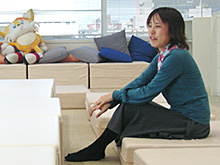Difference between revisions of "Makiko Nishimura"
From Sega Retro
m |
|||
| Line 13: | Line 13: | ||
==Production history== | ==Production history== | ||
| + | {{ProductionHistory|Makiko Nishimura}} | ||
| + | |||
[[Category:Use ProductionHistory template]] | [[Category:Use ProductionHistory template]] | ||
| − | |||
| − | |||
| − | |||
| − | |||
* ''[[Sonic and the Secret Rings]]'' (2007) — Lead Programmer, Player Character Programmer | * ''[[Sonic and the Secret Rings]]'' (2007) — Lead Programmer, Player Character Programmer | ||
* ''[[Sonic Unleashed]]'' (Wii & PS2 Version) (2008) — Special Thanks | * ''[[Sonic Unleashed]]'' (Wii & PS2 Version) (2008) — Special Thanks | ||
Revision as of 12:27, 21 July 2022

|
| Makiko Nishimura |
|---|
| Company(ies): Sonic Team, Sega of Japan |
| Role(s): Lead Programmer |
This teeny-tiny article needs some work. You can help us by expanding it.
Makiko Nishimura (西村 牧子) is a programmer for Sonic Team and the lead programmer and player character programmer for Sonic and the Secret Rings.
Nishimura was part of a theatre troupe in high school and college and held two part-time jobs working at her university and playing the organ at weddings when she was hired by Sega to do sound engineering and Electone work for Roommania #203. From there, she transferred to Sonic Team and became an enemy programmer for Sonic Adventure 2. Nishimura did enemy and stage programming for Sonic Heroes, worked at the sound stage program at Sega Studios USA (also called Sonic Team USA) and became the lead programmer and player character programmer for Sonic and the Secret Rings.
Production history
- Sonic Adventure 2 (Dreamcast; 2001) — Enemy Programmers
- Sonic Adventure 2 (Dreamcast; 2001) — Sound Effects Programmer
- Sonic Adventure 2: Battle (GameCube; 2001) — Enemy Programmers
- Sonic Adventure 2: Battle (GameCube; 2001) — Chao Programmers
- Sonic Adventure 2: Battle (GameCube; 2001) — Sound Effects Programmer
- Sonic Heroes (PlayStation 2; 2003) — Stage Programmers
- Sonic Heroes (GameCube; 2003) — Stage Programmers
- Sonic Heroes (Xbox; 2003) — Stage Programmers
- Sonic Heroes (PlayStation 2; 2003) — Enemy Programmers
- Sonic Heroes (GameCube; 2003) — Enemy Programmers
- Sonic Heroes (Xbox; 2003) — Enemy Programmers
- Sonic Heroes (Windows PC; 2004) — Main Programmers
- Sonic and the Secret Rings (Wii; 2007) — Lead Programmer
- Sonic and the Secret Rings (Wii; 2007) — Player Character Programmers
- Sonic and the Black Knight (Wii; 2009) — Lead Programmer
- Sonic and the Black Knight (Wii; 2009) — Character Programmers
- Wacky World of Sports (Wii; 2009) — Special Thanks
- Sonic Colours (Wii; 2010) — Lead Character Programmer
- Sonic Lost World (Wii U; 2013) — Gameplay Programmers
- Sonic Runners (iOS; 2015) — Special Thanks
- Sonic Runners (Android; 2015) — Special Thanks
- Sonic Colours: Ultimate (Xbox One; 2021) — Lead Character Programmer
- Sonic Colours: Ultimate (PlayStation 4; 2021) — Lead Character Programmer
- Sonic Colours: Ultimate (Nintendo Switch; 2021) — Lead Character Programmer
- Sonic Colours: Ultimate (??; 2021) — Lead Character Programmer
- Sonic Colours: Ultimate (Steam; 2023) — Lead Character Programmer
- Sonic and the Secret Rings (2007) — Lead Programmer, Player Character Programmer
- Sonic Unleashed (Wii & PS2 Version) (2008) — Special Thanks
- Sonic and the Black Knight (2009) — Lead Programmer, Character Programmer
- Wacky World of Sports (2009) — Special Thanks
- Sonic Colors (Wii Version) (2010) — Lead Character Programmer
- Sonic Lost World (Wii U Version) (2013) — Gameplay Programmer
- Sonic Runners (2015) — Special Thanks
Interviews
| Some or all of the following content should be mirrored on Sega Retro (or Retro CDN). |
Makiko Nishimura interview by Sonic Channel (April 2, 2007)